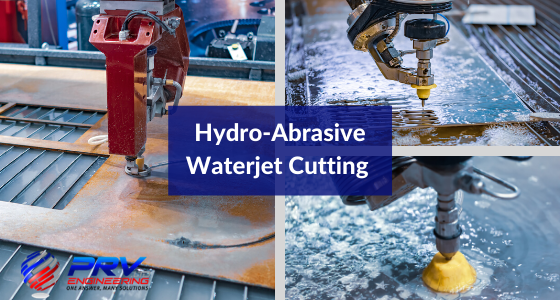The introduction of abrasive waterjet cutting into the manufacturing industry marked a pivotal advancement in how materials are processed. This technology, distinguished by its precision and efficiency, offers a non-thermal, water-driven method to cut a wide range of materials, from metals to composites, without altering their intrinsic properties.
Waterjet cutting has revolutionised the manufacturing industry, offering a myriad of advantages over traditional cutting methods. Among them, hydro-abrasive waterjet cutting stands out as a superior choice for a range of materials, including metal, stone, and glass. In this article, we take a look at the intricacies of this advanced technique, shedding light on its principles, advantages, applications, and comparisons with other cutting methods.
How Hydro-Abrasive Waterjet Cutting Compares to Traditional Methods
Hydro-abrasive waterjet cutting is a precision cutting technique that uses a high-pressure stream of water mixed with an abrasive substance to cut through materials. It is a versatile process that can be used to cut a wide range of materials, including metals, composites, glass, stone, and ceramics. In this article, we explore the advantages of this advanced process and some of its applications across various sectors.
CNC Waterjet cutting is a specialised manufacturing process that uses a high-pressure jet of water to cut or shape various types of materials. The power of the CNC waterjet cutting machine comes from a pressurising pump that uses a small precision nozzle. As the water exits the nozzle, it delivers a supersonic stream of water, about three times the speed of sound.
All materials can be cut by the same CNC Waterjet cutting machine, from soft rubber and plastics to the hardest metals and ceramics. This is hugely beneficial for companies who work within several sectors requiring different materials for various applications.
It offers customers a unique combination of flexibility, simplicity and precision unparalleled in other available technologies today. The small cutting widths and omni-directional cutting mean the machines can cut virtually any material with exceptionally high precision. Waterjet cutting offers extreme accuracy with tight tolerances and is especially suited to composites.
However, as good as waterjet cutting machines are, there are several misconceptions and PRV decided to set the record straight. Fact is, hydro-abrasive waterjet cutting has evolved remarkably and is one of the most effective machining methods today. This article aims at busting 8 common myths and shed some light on the services available at PRV Engineering.
Waterjet cutting is often used during the fabrication process of machine parts. This industrial tool is capable of cutting a wide variety of materials using a very high-pressure jet or stream of water. A mixture of water and an abrasive substance is also used in many applications. The highly versatile cutting method produces much less waste than other forms.
Waterjet cutting is also more environmentally friendly as it doesn’t produce dust, chippings or gas like other cutting methods. Engineering companies are implementing waterjet technology as a cost-effective, complementary machining method to cut parts to near-precise requirements. This greatly helps minimise waste, maximise raw material usage and accelerates overall production.
Another year has gone by and what better way to end it off than reflecting on the last 12 months. As a specialist engineering company, we work with a wide array of industries and our experience has enabled us to deliver interesting, relevant and informative articles. From engineering and manufacturing to new technologies, defence updates and future combat vehicles, we publish new content every week. After all, you can’t grow unless you learn something new every day.
With Christmas behind us and the focus shifting to the New Year, let’s take a look at some of the PRV Engineering blog highlights from 2018. Most articles focus on PRV Engineering services but we also added a few very interesting developments from around the world.
The evolution of hydro-abrasive waterjet cutting has been remarkable and is one of the most effective methods of machining. There is no heat affected zone (HAZ), the small cutting widths and omni-directional cutting means we can machine virtually any material with high precision and accuracy. As a result, waterjet cutting produces a much-improved product finish with little to no secondary processing needed.
Advanced technology and methods make waterjet cutting far more environmentally friendly. So much so that the dust, chippings or gas produced with other cutting methods do not occur. There is also no need to change tool heads, blades or lubricants for each type of material which means machining time is greatly reduced.
This highly versatile cutting method produces much less waste than other forms of cutting which allows for more diverse design. The ability to cut more intricate designs and patterns offers











Recent Comments